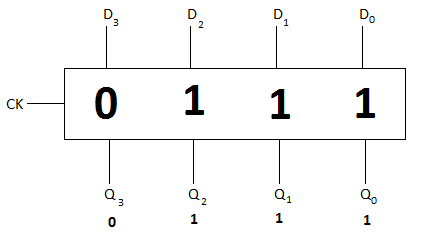|
Fig 5.5.2 is a schematic, block diagram of the same four bit register. The individual latches are no longer important and some details are left out. The number of flip-flops in a register usually reflects the size of the adder or the size of the bus or the size of a main memory cell. Many computers have 32-bit registers, although there are special purpose registers that may be wider or narrower. A group of registers is called the general purpose registers, which are used by assembly programmers to store intermediate values. It was common until recently to have 16 of these, each 32-bits wide. Since they exist in the main CPU, they are comprised of gates and are very fast. Modern RISC chips may have hundreds of registers, and some older computers have only a few. As of 2010, 64-bit registers are now the norm. The general purpose registers each have a numerical address, from 0 to 15, if there are 16 of them. Assembly programs refer to them usually as R0, R1, R2, ... R15, although all sorts of other notations are common. |
